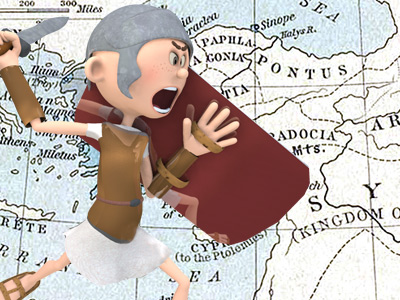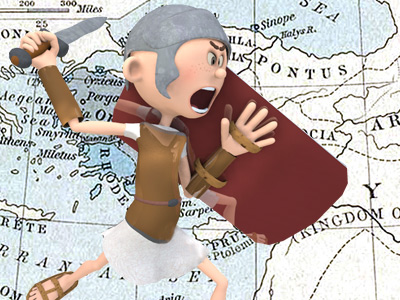Galatian War (189 BC)

Prelude
In 191 BC, Antiochus the Great, the Emperor of the Seleucid Empire of Asia invaded Greece. The Romans decided to intervene and they defeated the Seleucids at the Battle of Thermopylae. The defeat by Rome forced the Seleucids to retreat back to Asia Minor. The Romans The Roman Republic was a form of government of Rome and the era of the classical Roman civilization when it was run through public representation of the Roman people. Beginning with the overthrow of the Roman Kingdom (traditionally dated to 509 BC) and ending in 27 BC with the establishment of the Roman Empire, Rome's control rapidly expanded during this period - from the city's immediate surroundings to hegemony over the entire Mediterranean world. followed them across the Aegean Sea and together with their allies, Pergamum, they decisively defeated the Seleucids at the Battle of Magnesia.
The Roman Republic was a form of government of Rome and the era of the classical Roman civilization when it was run through public representation of the Roman people. Beginning with the overthrow of the Roman Kingdom (traditionally dated to 509 BC) and ending in 27 BC with the establishment of the Roman Empire, Rome's control rapidly expanded during this period - from the city's immediate surroundings to hegemony over the entire Mediterranean world. followed them across the Aegean Sea and together with their allies, Pergamum, they decisively defeated the Seleucids at the Battle of Magnesia.
The Seleucids sued for peace and began settling it with Scipio Asiaticus. In spring, the new consul, Gnaeus Manlius Vulso arrived to take control of the army from Scipio Asiaticus. He was sent to conclude the treaty that Scipio was arranging. However, he was not content with the task given to him and he started to plan a new war. He addressed the soldiers and congratulated them on their victory and then proposed a new war, against the Galatian Gauls of Asia Minor. The pretext he used for the invasion was that the Galatians had supplied soldiers to the Seleucid army at the Battle of Magnesia. The principal reason for the invasion was Manlius' desire to seize the wealth of the Galatians who had become rich from plundering their neighbours and to gain glory for himself.
This war was the first occasion that a Roman general had started a war without the permission of the senate or the people. This was a dangerous precedent and this became an example for the future.
Manlius started his war preparation by summoning the Pergamese to help. However, the King of Pergamum, Eumenes II was in Rome so his brother, Attalus who was the regent took command of the Pergamese army. He joined the Roman army a few days later with 1,000 infantry and 500 cavalry.
HISTORY

RESOURCES
This article uses material from the Wikipedia article "Galatian War", which is released under the Creative Commons Attribution-Share-Alike License 3.0.
© Stories Preschool. All Rights Reserved.









